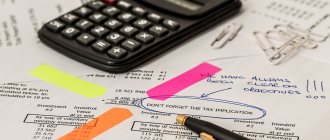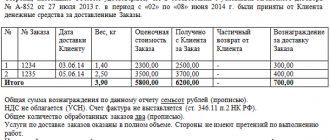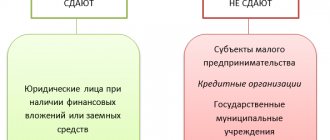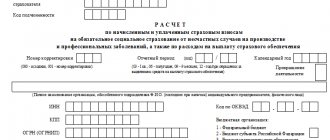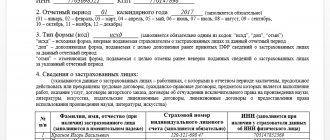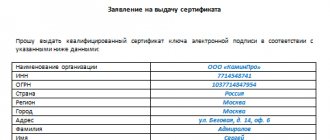Who must submit a balance sheet?
The balance sheet is one of the financial reporting forms.
The legislation establishes that all legal entities, regardless of their organizational form and the applicable taxation regime, must prepare and submit reports to tax and statistical authorities. This obligation also applies to non-profit organizations and bar associations. Balance sheets and profit and loss statements do not have to be submitted only to entrepreneurs, as well as branches of foreign companies. But they can do this on their own initiative.
Attention! Previously, some organizations were exempt from preparing a balance sheet, but currently such provisions are no longer in effect. Business entities classified as small businesses are given the right to submit reports in a simplified form. It includes a balance sheet in Form 1 and a statement of financial results in Form 2, so enterprises must send it to regulatory authorities.
How to draw up a balance sheet: an example for dummies
The balance sheet is one of the main financial reports of any company. It reflects many basic indicators characterizing the financial position of the company. It is used not only within the company, but also by many third parties, including regulatory authorities. Therefore, the correctness of the document is of particular relevance when preparing reports.
Balance due dates
According to the general rules, the balance sheet - Form 1 must be submitted as part of the reporting for the past year no later than March 31 of the following year. This deadline must be observed when submitting balance sheets and other forms to the Federal Tax Service and statistics.
In addition, under certain conditions, an audit report must be sent to Rosstat as an attachment. The deadline is set for ten days, but no later than December 31 of the following year.
Some organizations need to submit financial statements and publish them due to the type of activity they carry out, or according to other criteria defined by law. For example, tour operators must send their reports to Rostrud within three months from the date of their approval.
The legislation provides for separate deadlines for organizations that registered after September 30 of the reporting year. Due to the fact that their calendar year may be determined differently in this case, the due date may be set by such organizations on March 31 of the second year after the current one. For example, Rebus LLC received an extract from the Unified State Register of Legal Entities on October 25, 2017; the accounting report must be submitted for the first time on March 31, 2021.
Attention! Accounting statements are usually submitted based on the total for the year. However, it is possible to present it quarterly. In this case it is called intermediate. Such documentation is very often needed when applying for loans from banks, company owners, etc.
Balance sheet structure
The balance sheet of an enterprise characterizes the financial position of an economic entity as of a specific reporting date and is a table with certain columns. Since it reflects assets and liabilities, the table is divided into two large sections:
- Asset – to reflect the property and assets of the organization,
- Liability – to reflect the obligations of the organization.
Each section of the balance sheet is divided into groups that have individual lines with a specific name. The current form of the balance sheet can be taken from the order of the Ministry of Finance of the Russian Federation “On the forms of financial statements of organizations” dated July 2, 2010 No. 66n. Note that you cannot delete any lines from it, but you can add columns if necessary.
Line-by-line information is collected from synthetic accounting accounts or taken from the balance sheet for a specific period.
Where is it provided?
The provisions of federal laws establish that Form 1 balance sheet and Form 2 profit and loss statement, and in certain cases other forms, must be submitted:
- Federal Tax Service - reporting must be submitted at the place of registration of the company. Therefore, branches and other separate divisions do not submit it, and only the parent company submits consolidated statements. This must be done at the place where it is registered, taking into account these departments.
- Rosstat - currently submitting reports to statistical authorities is mandatory. If this is not done, then, just as in the first case, the company and officials may be held liable.
- For the founders and other owners of the company - this is due to the fact that each annual report of the organization must be approved by its owners.
- To other bodies, if the relevant regulations define such a duty.
Attention! Banks may be asked to provide reporting when applying for various types of loans and borrowings from them. Especially if you take out a loan to open or develop a business.
Currently, when concluding contracts, many large companies ask for Form 1 Balance Sheet, Form 2 Profit and Loss Statement. This should be done at the discretion of the company management.
However, at present, many specialized companies through which you can submit reports have a service that allows you to obtain all the necessary information about a partner according to his TIN or OGRN. This data is provided by the Federal Tax Service itself based on previously submitted reports.
You might be interested in:
Profit and loss statement form 2 balance sheet: how to fill out in 2021, main mistakes
What is a balance sheet and why is it prepared?
Most Russian companies compile and present various accounting reports.
The main set of such reporting includes five forms:
- Form No. 1 - “Balance Sheet;
- Form No. 2 - “Report on financial results”;
- Form No. 3 - “Report on changes in capital”;
- Form No. 4 - “Cash Flow Statement”;
- Form No. 5 - “Appendix to the Balance Sheet”.
I propose to take a closer look at form No. 1 – balance sheet.
The balance sheet is information about the company’s property (assets) and the sources of its acquisition (liabilities), grouped as of the reporting date in the form of a table. An asset is always equal to a liability!
Let's get acquainted with the principles of drawing up a balance using the example of the budget of one Russian family.
Example
A large, friendly Pugovkin family lives in the city of N. The family is wealthy by city standards. They have: an apartment, a car, household appliances, furniture, clothes, food, a summer house. In addition, there is money in the wallets and bank accounts of family members.
In general, the Pugovkins have everything they need for a comfortable active life. These will be the assets of the Pugovkin family.
Take a sheet of blank paper and write all of the above in 2 columns.
Assets of the Pugovkin family:
| Article | Name | Cost, thousand rubles |
| 1 | Apartment | 4 000 |
| 2 | Country house | 1 000 |
| 3 | Car | 1 100 |
| 4 | Appliances | 300 |
| 5 | Products | 50 |
| 6 | Money in wallets | 30 |
| 7 | Money in the bank | 450 |
| 8 | Furniture | 610 |
| 9 | Cloth | 40 |
| 10 | Total | 7 580 |
To acquire all this, the family needed funds. Therefore, the Pugovkins took out a bank loan and borrowed part of the money from friends. In addition, the Pugovkin family currently has unpaid utilities and property taxes.
A bank loan, debt to friends, unpaid utility bills and taxes are the liabilities of the Pugovkin family.
Liabilities of the Pugovkin family:
| № | Name of liability | Cost, thousand rubles. |
| 1 | Bank loan | 6 184 |
| 2 | Debt to friends | 1 200 |
| 3 | Debt to utilities | 11 |
| 4 | Tax debt | 25 |
| 5 | Salary of family members | 160 |
| 6 | Total | 7 580 |
The assets and liabilities of the balance sheet are divided into several parts.
Asset sections:
- non-current assets;
- working capital.
Passive sections:
- capital and reserves;
- long term duties;
- Short-term liabilities.
The balance sheet is in demand by various users.
External users:
- tax authorities;
- banks;
- investors;
- partners (counterparties).
Internal users:
- shareholders of the company;
- planning and analytical department.
Delivery methods
The OKUD form 0710001, which is part of the annual report, can be submitted to the Federal Tax Service and Rosstat in the following ways:
- Personally by a company representative to an inspector or Rosstat specialist.
- By sending through the postal service - in this case, the letter is subject to requirements for the content of the inventory, and it must also be valuable.
- Through an electronic document management system - in this case, the company must have an appropriate electronic digital signature (EDS) and enter into an agreement with a special operator. You can also send the aileron file with reporting through the tax website; you will also need an enhanced digital signature.
Attention! The legislation stipulates the submission of the report in electronic form if the number of employees of the organization is more than 100 people.
Balance sheet form 2021 free download
Balance sheet form 1 form 2021 free download in Word format.
Balance sheet form 1 form 2021 download free in Excel format.
Balance sheet with line codes form download in Excel format.
Download a sample of filling out the balance sheet in Form 1 for 2021 in PDF format.
Filling out a balance sheet: example with explanation
To prepare or check a prepared balance sheet, an accounting register such as a balance sheet is usually used. But you only need to take from it the balance indicators, i.e. the balance, because the balance sheet reveals data for a certain date, and not for a period. Along with the balance sheet, account transcripts and other analytical data are used as necessary.
Below we will show you how to make a balance sheet using an example with step-by-step instructions.
Let us give an example of the balance sheet of Zima LLC as of December 31, 2017. For simplicity, we will assume that the organization was created in 2021. Therefore, there will be no comparative reporting indicators as of 12/31/2016 and 12/31/2015 in the balance sheet. Considering that the data of assets and liabilities in the balance sheet in general are not subject to offset, the balance sheet must be presented in expanded form. This means that active-passive accounts will reflect both debit and credit balances.
You can view the balance sheet for 2021 here.
To fill out the balance sheet, we provide a breakdown of individual accounting accounts. Let us note that the balance of accounts 60 “Settlements with suppliers and contractors” and 62 “Settlements with buyers and customers” consists exclusively of short-term liabilities.
The balance of account 97 represents expenses for used software products (non-exclusive rights) of a long-term nature.
For each line of the balance sheet, we provide explanations of the order in which the existing balance is reflected in the balance sheet.
The balance sheet filled out based on the example given can be downloaded from the link below.
Completed balance sheet of the enterprise: download
How to fill out a balance sheet using Form 1
Title part
After the name of the form, it is indicated on what date it is being generated. The actual date of submission of the report must be entered in the table, in the line “Date (day, month, year)”. Next, the full name of the subject is written down, and opposite in the table is its OKPO code.
After this, his TIN is indicated on the next line in the table. Next, you need to indicate the main type of activity - first in words, and then in a table using the OKVED2 code. Then the organizational form and form of ownership are indicated.
On the contrary, the corresponding codes are entered in the table, for example:
- The code for LLC is 65.
- for private property - 16.
On the next line you need to choose in what units the data in the balance sheet is presented - in thousands or millions. The table displays the required OKEI code. The last line contains the address of the subject's location.
Assets
Fixed assets
Line “Intangible assets” 1110 is the balance of account 04 (except for R&D work) minus the balance of account 05.
Line “Research results” 1120 - account balance 04 for sub-accounts that reflect R&D;
Line “Intangible search requests” 1130 - account balance 08, subaccount of intangible costs for search work.
Line “Material search requests” 1140 – account balance 08, subaccount for the costs of material assets for search work.
Line “Fixed assets” 1150 - account balance 01 minus account balance 02.
Line “Income-bearing investments in MC” 1160 - the balance of account 03 minus the balance of account 02 in terms of accrued depreciation on assets related to income-generating investments.
Line “Financial investments” 1170 - account balance 58 minus account balance 59, as well as account balance 73 in terms of interest-bearing loans over 12 months.
Line “Deferred tax assets” 1180 - account balance 09, it is possible to reduce it by account balance 77.
Line “Other non-current assets” 1190 - other indicators that need to be reflected in the section, but they are not included in any line.
The line “Total for section” 1100 is the sum of lines from 1110 to 1190.
Current assets
Line “Inventories” 1210 - the sum of indicators is entered in the line:
- account balance 10 minus account balance 14, or account balances 15, 16
- Balances on production accounts: 20, 21, 23, 29, 44, 46
- Balances of goods on accounts 41 (minus the balance on account 42), 43
- account balance is 45.
Line “Value added tax” 1220 - account balance 19.
Line “Accounts receivable” 1230 - the sum of indicators is entered:
- Debit balances of accounts 62 and 76 minus the credit balance of account 63 in the subaccount “Reserves for long-term debts”;
- The debit balance of the account is 60 for advances made for the supply of products and services.
- Debit balance of account 76, subaccount “Insurance payments”;
- The debit balance of the account is 73, excluding the amounts of loans on which interest is accrued;
- Debit balance of account 58, subaccount “Granted loans for which interest is not accrued.”
- Debit account balance 75;
- Debit account balance 68, 69
- The debit balance of the account is 71.
You might be interested in:
Information on the average number of employees: sample filling, form
Line “Financial investments” 1240 - the sum of indicators is entered:
- account balance 58 minus account balance 59;
- account balance 55, subaccount “Deposits”;
- account balance 73, subaccount “Loan settlements”.
Line “Cash” 1250 - the sum of account balances 50, 51, 52, 55, 57 is entered.
Line “Other current assets” 1260 - indicators that should be shown in the section, but were not included in any previous line.
The line “Total for section” 1200 is the sum for lines from 1210 to 1260.
Line “Balance” 1600 - the sum of lines 1100 and 1200.
Passive
Capital and reserves
Line “Authorized capital of the organization” 1310 - account balance 80.
Line “Own shares” 1320 - account balance 81.
Line “Revaluation of non-current assets” 1340 - account balance 83 in terms of the amounts of revaluation of fixed assets and intangible assets.
Line “Additional capital” 1350 – account balance 83 without the amounts of additional valuation of fixed assets and intangible assets.
Line “Reserve capital” 1360 - the sum of account balances 82, as well as 84 in terms of special funds.
Line “Retained earnings (uncovered loss)” 1370 - account balance 84 without special funds.
Line “Total for section” 1300 - the sum for lines 1310, as well as from 1340 to 1370 minus line 1320.
long term duties
Line “Borrowed funds” 1410 - account balance 67, including the amount of loans and interest accrued on them.
Line “Deferred tax liabilities” 1420 - account balance 77, it can be reduced by account balance 09.
Line “Estimated liabilities” 1430 - account balance 96 for the subaccount of estimated liabilities for more than 12 months.
Line “Other liabilities” 1450 - credit balances of accounts , , 68, 69, , 76 for which liabilities with a maturity period of more than 12 months are reflected.
Line “Total for section” 1400 - the sum for lines from 1410 to 1450.
Short-term liabilities
Line “Borrowed funds” 1510 - account balance 66, including loan amounts and interest accrued on them.
Line “Accounts payable” 1520 - The amount of indicators is entered in the court:
- Balances of accounts 60 and 76, which show the debt to suppliers and contractors;
- The balance on the credit of account 70, except for the debt on payment of income on shares and shares;
- The balance on the credit of the sub-account “Settlements on deposited amounts” of account 76;
- Credit balances of accounts 68 and 69;
- Account credit balance 71;
- Balances on the subaccounts “Calculations for claims” and “Calculations for property insurance” on account 76;
- Credit balances on accounts 76 and 62 for advances received;
- Credit balance on the subaccounts “Calculations for the payment of income” of account 75 and “Calculations of income for the payment of income on shares” of account 70
Line “Deferred income” 1530 - loan balances for accounts 86 and 98.
Line “Estimated liabilities” 1540 - balance from account 96 in the subaccount of estimated liabilities for less than 12 months;
Line “Other short-term liabilities” 1550 - other short-term liabilities that cannot be included in the previous terms of Section V.
The line “Total for section” 1500 is the sum for lines from 1510 to 1550.
Line “Balance” 1700 - the amount for lines 1300, 1400 and 1500.
How to make a balance sheet from SALT
In this article I was going to show how to make a balance sheet from SALT. However, having figured out how I would do this, I realized that I would start using accounting rules and terms. And I’m not sure that you and I will have the same understanding of them. So, I came up with this.
I am not interested in writing a purely theoretical article. I want to engage you so that together we can go from “reviewing SALT” to filling out the balance sheet.
For this I have my own approach: when giving new knowledge, I strive to ensure that there is a repetition of the previous ones. In other words, we repeat the knowledge that serves us as a support for new ones.
I would like to note that in this series of articles about filling out a balance sheet, I will talk about general ideas, basic rules, and show how it is done. Together with me, you will go all the way to creating a balance sheet based on the OCB of a real enterprise.
So, let's go...
Here is the OCB of a working enterprise. In the previous article, we prepared her for creating a balance sheet .
Please note that I added two empty columns to the OCB: “Name” and “AP”. Why did I do this? I answer - For independent work, for warming up and remembering past knowledge.
Here's what we should do now:
- download the balance sheet and open it
- In the “name” column, write the name of the account. No need to look at the chart of accounts. There is no need to achieve some exact match between the name of the account and what it is called in the chart of accounts. Just remember and write. It is enough that your name reflects the essence of the account. For example . I will call the 50th account “Cashier”. And in the chart of accounts it can be called “Enterprise Cash Office”.
- in the “AP” column for each account, indicate what it is, “A – active account”, “P – passive account” or “AP – active-passive account”. Hint : Active accounts are those that store information about what the company has and this is “what” helps the company operate and earn money. Usually “it” can be touched. Active accounts always have a debit balance or zero. Liability accounts are the debts/obligations of our company. This is simply information about the amounts owed. Passive accounts always have a credit balance or zero.
Of course, putting down “A, P and AP” is not an easy task. This requires knowledge and some reflection. I agree that there are invoices where you can issue them right away, and somewhere you can use a hint and enter the required characteristics. In any case, put it where you can do it. And fill in the remaining empty cells according to the chart of accounts. Download the chart of accounts.
Once you solve the problem, compare it with what I did.
If you are subscribed to blog updates by email, enter the access code from the last mailing letter. To receive an access code, subscribe to blog news.
CONCLUSION
To finish this article, I propose to do a practical task. We'll work a little with the numbers from the OS. The task is:
- divide your sheet in a notebook or notepad into two columns: “Asset” and “Passive”
- from SALT we will work with the column “Balance at the beginning of the period”
- according to all the rules studied in this article - write out the accounting accounts and amounts, what can be classified as “Asset” and what can be classified as “Liability”
- In each column, calculate the total of all amounts
- compare the total amount of “Asset” and the total amount of “Liability”
To complete the task, you already have previously downloaded OSV. If you haven't downloaded it yet, download it here.
If you are subscribed to blog updates by email, enter the access code from the last mailing letter. To receive an access code, subscribe to blog news.
Perhaps now we are ready to fill out the balance sheet. We will do this in the next article. I invite you.
Common mistakes when filling out a balance
When filling out a balance sheet, novice accountants often make the following mistakes:
- Accounts receivable and payable are shown as a collapsed indicator. This is a mistake - in the balance sheet you need to show separately the debt to debtors or creditors and separately - received or paid advances. Profits and losses should be reflected using the same principle.
- The amount of the advance received should not be reflected in pure form, but together with the VAT received with this payment.
- Fixed and intangible assets are reflected at historical cost. This is not true. These values must be adjusted to the amount of accrued depreciation for each type of property.
- Interest-free loans are shown as part of financial investments. This is incorrect; they should be shown as part of accounts receivable by maturity.
- Negative indicators are written with a minus sign. According to the instructions for filling out the form, negative values must be shown in parentheses without a minus.
Technique and procedure for drawing up a balance sheet
The balance sheet is formed by the responsible person while filling out individual lines of the form. When filling out, it is necessary to take into account the specifics of the company’s activities, as well as correctly distribute the indicators.
Both report tables include lines that indicate indicators characterizing the financial position of the company and each has a separate serial number with the name of the position.
The total amount of the asset is formed based on the entered indicators by adding them up:
The liability side of the balance sheet is filled in using the same principle:
If a zero indicator is entered in separate lines of the balance sheet, then this fact should be reflected in the accompanying documentation. When filling out, designations in thousands or millions of rubles are used. The choice of indicator is determined in the header of the form when filling out the balance:
Drawing up a balance sheet is quite simple if you have an idea of the rules for its formation, as well as take into account the features and nuances of the distribution of assets and liabilities of the company.
